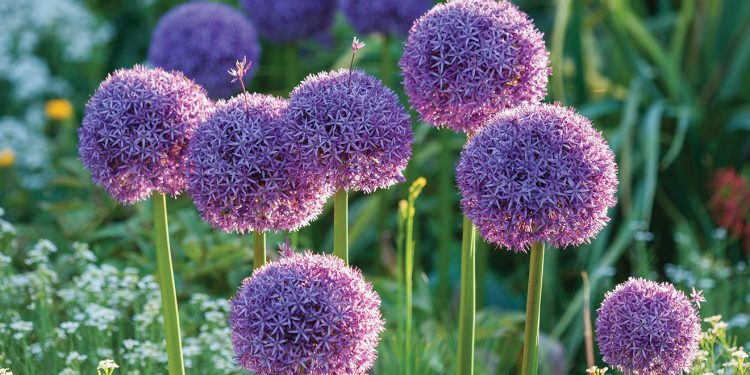A true act in patience, lush spring flower beds get their start in autumn when the air is cool and leaves are crisp. Spring-blooming bulbs such tulips, daffodils, hyacinth and more do best when planted in fall because the cool, moist autumn soil allows the bulb to begin rooting before the cold of winter sets in. Here in central Illinois, the ideal time to plant bulbs is October through November, when nighttime temperatures have been consistently in the mid-50s for a couple of weeks. Although they do require a bit of planning, spring bulbs are an easy drop-and-go gardening project that even a novice can pull off.
Spring-blooming bulbs that should be planted in fall include crocus, daffodils, allium, muscari, hyacinth and snowdrops. When shopping for bulbs, consider the bloom time of each variety (such as early or late spring) and plant accordingly for bright flowers all season long. Daffodils, crocus, muscari and snowdrops will generally bloom first, followed by hyacinths, tulips, allium and finally, the iris in early summer. Deer and other critters are also important to consider when deciding which bulbs to plant –deer love tulips. Thankfully, they eschew alliums, daffodils, hyacinths, snowdrops and iris, so there’s still a variety to choose from if you share your garden with wildlife.
Look for firm bulbs with shiny, intact skins and no sign of mold or mildew. The area where they are to be planted should have at least partial sun throughout the spring and into early summer with soil that is fertile and well-drained. In general, a bulb should be planted to a depth of three times its size. Smaller bulbs like crocus will only be planted two to three inches deep, while jumbo tulip bulbs should be planted to a depth closer to eight inches.
If you plan on planting lots of bulbs, it’s a good idea to invest in a bulb auger that attaches to a power drill. They can easily be found for less than $20 and save significant time and wrist pain. Place the bulb in the hole with the pointed end up before filling back up with dirt. Add a thin layer of compost and weed-free mulch over the top of the planting area to help retain moisture and stifle weeds.
The incredible tulip and bulb displays that you see at botanical gardens and theme parks were likely planted the previous season and will be dug up the following year. Indeed, unless they are listed as perennial tulips, most tulips are only guaranteed to consistently bloom for a season or two. Varieties that are considered perennial tulips can be expected to bloom well for five, and even up to 10 years. That said, I have a planting of supposedly non-perennial tulips, including fancy double and parrot types, that have bloomed well for four seasons now. I’m simply shocked and elated every time they pop up. Tulips are indeed beautiful, but they can be finicky – perhaps that contributed to their unhinged popularity and value in the Netherlands centuries ago.
If you’re a more low-maintenance-type gardener, consider planting bulbs that will naturalize. Varieties such as allium, crocus, chindoxia and especially daffodils are good candidates for naturalizing, meaning that they will come back reliably each season and will spread informally around your garden or yard. Once bulbs have finished blooming for the season, it is important to allow the foliage to die back naturally before mowing it or cutting it back. This allows the leaves to continue creating energy to store in the bulb to grow blooms for the next season.
And finally, when you are at last rewarded with a gorgeous array of spring blooms, resist the urge to arrange daffodils and other narcissus-type flowers in bouquets with other flowers, such as tulips. The sap that drains from the cut daffodil will impair other flowers’ ability to take up water, causing them to wilt sooner.
Source by www.illinoistimes.com















































